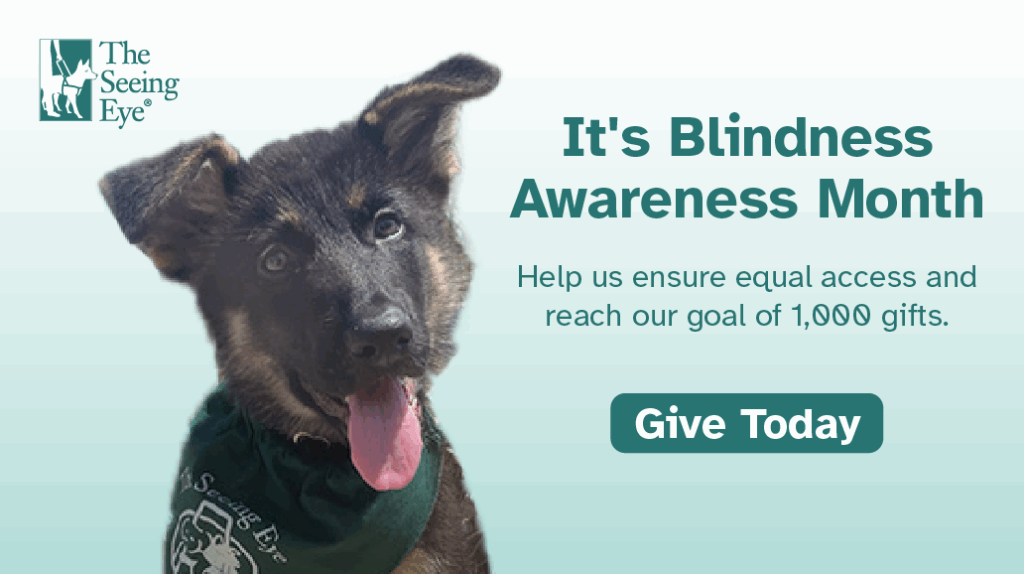Access & Advocacy
Airlines & Cruise Ships
Airlines & Cruise Ships
Due to the efforts of The Seeing Eye’s cofounder Morris Frank and other dedicated advocates, guide dog handlers today enjoy the same modes of travel as people without service animals. Of course, with travel opportunities come a number of challenges. It is a good idea for guide dog handlers to have an understanding of their rights and responsibilities while traveling. Air carriers, public entities and government agencies also have a responsibility to be informed about which laws apply to them and how to appropriately engage with guide dog handlers. Here is some information about common issues and questions that come up when guide dog handlers travel.
Air Travel
The Air Carrier Access Act (ACAA) is the law that protects people with disabilities from discrimination in air travel on all flights of U.S. airlines and on flights to or from the United States by foreign airlines. For more information about the rights of passengers with disabilities under the ACAA regulations, check out Airline Passengers with Disabilities Bill of Rights. For information about air transportation regulations applicable in Canada, check out our transportation page.
On September 22, 2023, The Seeing Eye’s Dave Johnson, Melissa Allman, and Sandee Moreta presented a webinar on air travel.
On January 11, 2021, the Department of Transportation’s updated final Air Carrier Access Act Regulations on Traveling by Air with Service Animals took effect. You can read a full version of the regulations in the Federal Register. Here are some important points to keep in mind about the regulations.
- Only dogs are service animals under the current regulations. A service animal is defined as a dog, regardless of breed or type, that is individually trained to do work or perform tasks for the benefit of a qualified person with a disability. This definition does not cover emotional support animals, which can now be classified as pets by the airlines. Note that psychiatric service animals are included in the definition.
- Airlines can determine if a dog is a service animal by 1) asking if the dog is a service animal needed because of a disability and what task it is trained to perform; 2) observing the animal’s behavior; or 3) taking note of indicators like leashes, harnesses, or vests.
- Airlines are allowed to require people traveling with service animals to submit a form called the Service Animal Air Transportation Form, attesting to the animal’s health, training, and behavior.
- If a service animal handler is traveling on a flight that is 8 hours or longer, airlines can also require them to complete a Service Animal Relief Attestation Form stating that the animal will not need to relieve during the flight or that relieving can be managed in a safe and sanitary way.
- If airlines choose to require the forms, they must use standard forms developed by DOT. Find an accessible and fillable copy of the Service Animal Air Transportation Form on DOT’s web site.
- The regulations require U.S. airlines to provide an accessible and fillable version of the forms on their web site and at airports where they operate. Foreign airlines must have copies of the forms at each airport serving flights that begin or end in the U.S.
- Airlines are allowed to require passengers to submit the forms electronically or in hard copy. Airlines can require passengers to submit the forms 48 hours in advance of a flight or at the gate. However, airlines are supposed to try to accommodate passengers who do not complete the forms in advance if doing so will not delay the flight. For reservations made less than 48 hours before the flight, airlines cannot require the forms in advance but can require the passenger to submit the forms at the gate. An airline is required to accommodate a passenger who requests assistance completing the forms.
- The handler must submit current forms. This means they have to be completed on or after the date the ticket was purchased. Airlines can require the forms for each round trip but not more than once in a trip.
- Airlines are not allowed to require people with service animals to check in at the airport. They must be allowed to check in online if they choose to do so.
- Airlines can limit the number of service animals traveling with a person with a disability to two. This means no more than two animals per person. There is no restriction on the number of service animals per flight.
- Airlines can require service animals to fit within the passenger’s foot space or on their lap. However, airlines are still required to accommodate passengers with large service animals that cannot fit in the foot space by offering another seat in the same class of service if available.
- Airlines are allowed to require that service animals be harnessed, leashed, or tethered at all times in the airport and on the aircraft. Guide dog handlers who choose to remove the harness so the dog can fit under the seat must leave the leash on.
- Airlines are allowed to charge service animal handlers for damages caused by the animal if they would charge passengers without service animals for similar damage.
- Airlines are allowed to refuse transportation to animals that are aggressive or engaging in behavior that shows they are not trained to behave appropriately in public. The assessment must be based on objective observations by airline personnel. An airline may choose not to classify a dog as a service animal if it is observed biting; barking; jumping; lunging; injuring people or other animals; or urinating or defecating on the aircraft or in the gate area.
- Passengers working with guide dogs may want to ask to preboard in order to have additional time to get situated at their seat with their dog. The handler must affirmatively let the airline know they are a person with a disability and that they need to preboard and the airline should make this accommodation.
- A person with a service animal cannot be required to sit in a bulkhead seat unless they purchased a bulkhead seat, but they can request a bulkhead seat as an accommodation.
- A service animal team cannot be seated in an emergency exit row seat. An airline is not required to upgrade the passenger to a different class of service to accommodate their service animal.
- Once you’ve decided which airline you will be flying on, it’s a good idea to check out their policies on service animals so you know how they are applying the regulations. Check out this information from some major U.S. and Canadian carriers:
Passengers who feel that an airline has discriminated against them should request immediate on site assistance from a Complaint Resolution Official (CRO). The airline is required to make a CRO available either in person or via phone. If an airline does not provide a CRO or the passenger is dissatisfied with the resolution of the complaint, they can also file a complaint with the Department of Transportation Office of Aviation Consumer Protection. Discrimination may include an airline’s failure to provide required DOT forms in an accessible format. For questions or assistance with a disability-related matter, passengers may also call the Aviation Consumer Disability Toll-Free Hotline at (800) 778-4838 between 9 a.m. and 5 p.m. Monday through Friday.
Service Animal Relief Areas in Airports
Airports that serve more than 10,000 passengers per year are required to have a wheelchair accessible service animal relief area at each terminal. The Department of Transportation has not adopted specific requirements concerning the dimensions, design, materials, and maintenance of relief areas, but airports are required to consult with service animal training organizations on these matters when designing relief areas. The relief areas are to be located past the security checkpoints with some limited exceptions, such as when TSA prohibits an airport operator from placing the relief area past the checkpoint for security-related reasons. There may also be circumstances where relief areas are located outside security because a service animal organization, the airport operator, and the airlines in the terminal have agreed that this location is better due to the airport’s configuration. Service animal relief areas are to be kept clean and designed in a way that makes regular and effective cleaning possible. Airlines are required to work with airport operators to provide escorts for people with disabilities to service animal relief areas upon request. However, you may find it helpful to obtain information about the location of service animal relief areas in airports before you travel when possible. If you believe that a service animal relief area does not comply with federal law or regulatory requirements, contact the FAA’s Airport Disability Compliance Program for information about actions you can take including filing a complaint.
Airport Security Checkpoints
The Transportation Security Administration (TSA) is responsible for screening air travelers with service animals. Passengers are expected to maintain control of their service dogs by holding onto the leash throughout the screening process. Passengers with animals may also be subject to explosives trace testing. At no time should TSA personnel require that the dog be separated from its handler or that the harness, collar or leash be removed from the dog. If a passenger exits past the checkpoint to relieve his or her dog, the passenger and dog will need to undergo the screening process again. When he or she returns to the security checkpoint, he or she can ask to move to the front of the screening line.
Travelers with complaints about the screening process may request immediate on site assistance from a TSA supervisor or Passenger Support Specialist. Prior to travel, passengers with questions about screening policies, procedures or what to expect when they arrive at the airport security checkpoint may call TSA Cares at 1-855-787-2227 or email TSA-ContactCenter@dhs.gov. A guide dog handler who needs to file a formal complaint against a Transportation Security Officer (TSO) can do so by calling the TSA Contact Center at 866-289-9673 or file a complaint online.
Cruising with a Guide Dog
Planning a cruise with your guide dog involves two parts. First, you will need to contact the cruise line to make arrangements for your dog. Many cruise lines require an international health certificate and current vaccination records. Generally a 4’ x 4’ wooden box filled with mulch or other type of absorbent material is provided for the relief area. Early boarding for orientation tours is often available upon request and can be a good idea if you need time to get your dog acclimated to their surroundings including relieving area. There is no limitation on the number of service animals that can be brought on a given voyage and passengers may bring a reasonable quantity of dog food aboard the vessel at no additional charge.
Second, passengers cruising with service animals must also obtain all customs and other governmental approvals so that the dog may disembark with the handler in the various ports of call. Many countries have strict entry requirements for service animals and some do not allow service animals at all. Be sure to check with the cruise line to see what options, if any, are available for leaving your dog on the ship. Some cruise lines do not allow you to leave your dog on the ship and ultimately you are responsible for your dog’s care and relieving needs.








